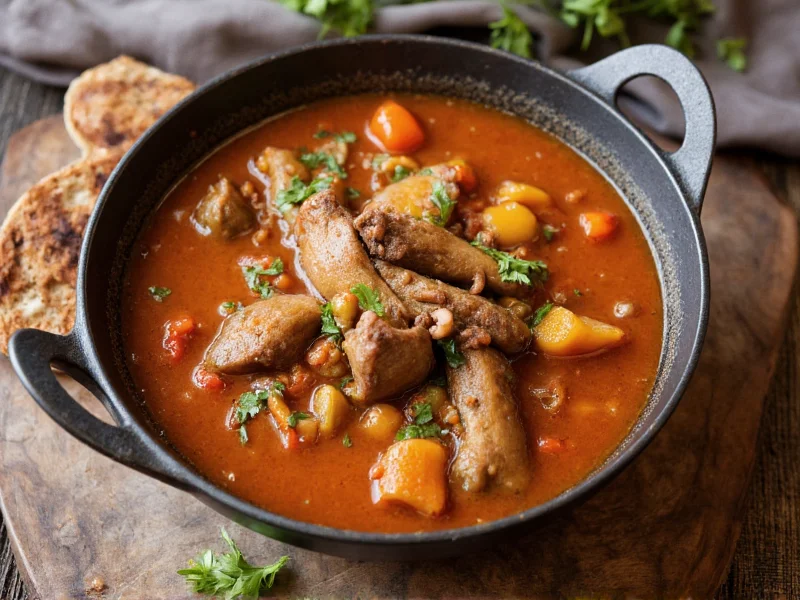Ox tail soup represents one of the most universally cherished comfort foods across diverse culinary traditions. This hearty preparation transforms tough connective tissues through slow cooking into a luxurious, nutrient-dense broth that has sustained cultures worldwide for centuries. The magic happens when collagen in the tail bones breaks down during extended simmering, creating that signature silky texture impossible to replicate with other cuts.
The Historical Journey of Ox Tail Soup
Originally born from necessity rather than luxury, ox tail soup emerged as a brilliant solution to utilize every part of the animal. Butchers considered tails undesirable byproducts until resourceful cooks discovered their potential. In 18th century England, "tailed beef" recipes appeared in cookbooks like Hannah Glasse's The Art of Cookery Made Plain and Easy, establishing the foundation for modern preparations. Across the Atlantic, Jamaican oxtail soup evolved with African and Taino influences, incorporating Scotch bonnet peppers and allspice. Korean kkori gomtang developed as a restorative broth for laborers, while Chinese versions often include medicinal herbs.
Anatomy of Quality Ox Tails
Selecting proper ox tails significantly impacts your soup's outcome. Modern "ox tails" actually come from cattle of any gender, typically cut into 2-3 inch segments with the bone running through the center. The best cuts show:
| Quality Indicator | Acceptable | Avoid |
|---|---|---|
| Color | Bright red meat with creamy white fat | Brownish meat or yellow fat |
| Marbling | Visible fat streaks throughout | Dry, lean appearance |
| Bone-to-meat ratio | Approximately 50/50 balance | Excessive bone with minimal meat |
For authentic how to make ox tail soup from scratch experiences, seek butcher-cut tails rather than pre-packaged supermarket versions. Local butchers often provide tails with superior marbling and connective tissue content essential for that luxurious mouthfeel.
Mastering the Cooking Process
Perfect ox tail soup requires understanding three critical phases:
- Blanching (15 minutes): Cover tails with cold water, bring to boil, then drain and rinse. This removes impurities for a clearer broth.
- Simmering (3-4 hours): Return tails to fresh water with aromatics. Maintain gentle simmer—never a rolling boil—to prevent cloudiness.
- Reduction (30-60 minutes): After removing meat, boil broth vigorously to concentrate flavors and achieve proper viscosity.
The ideal ox tail soup cooking time varies by method. Traditional stovetop requires 3-4 hours for fork-tender meat, while pressure cookers reduce this to 60-90 minutes. Never rush the process—collagen needs sufficient time to transform into gelatin. When properly cooked, the meat should slide effortlessly from the bone with minimal pressure.
Classic Recipe Framework
Follow this professional template for consistently excellent results:
Ingredients
- 3 lbs ox tails, cut into segments
- 1 large onion, quartered
- 3 carrots, roughly chopped
- 3 celery stalks, roughly chopped
- 4 garlic cloves, smashed
- 1 tablespoon black peppercorns
- 2 bay leaves
- 1 bunch parsley stems
- 8 cups cold water or beef stock
Method
- Blanch tails in boiling water for 10 minutes, then rinse thoroughly
- Place in large pot with all ingredients except parsley leaves
- Cover with cold water by 2 inches, bring to gentle simmer
- Skim foam aggressively during first 30 minutes
- Cover partially, simmer 3-4 hours until meat is tender
- Remove tails, strain broth, return meat to defatted broth
- Add fresh parsley, adjust seasoning, serve immediately
Global Variations Worth Exploring
Different cultures have perfected unique approaches to ox tail preparation:
Jamaican Oxtail Soup/Stew
This rich variation features butter beans, thyme, and Scotch bonnet peppers. The authentic Jamaican oxtail soup recipe includes marinating tails overnight in green seasoning (scallions, thyme, garlic, scotch bonnet) before browning. Many versions incorporate red wine and tomato paste for depth, creating a thicker stew-like consistency rather than a clear broth.
Korean Kkori Gomtang
Korean chefs achieve remarkable clarity through meticulous skimming and extended cooking (often 8+ hours). The traditional Korean kkori gomtang preparation involves changing water multiple times during initial blanching. Served with salt, scallions, and kimchi, this restorative broth embodies Korean hansik principles of healing through food.
English-Style Ox Tail Soup
The classic English ox tail soup features pearl barley and a lighter broth. Historically served as a Sunday supper dish, this version often includes a splash of Madeira wine added at the end. The meat typically remains on the bone for serving, distinguishing it from French consommé-style preparations.
Maximizing Nutritional Benefits
Ox tail soup offers remarkable nutritional advantages beyond basic sustenance. The slow cooking process releases:
- Collagen: Converts to gelatin during cooking, supporting joint health and skin elasticity
- Glycine: An amino acid that aids digestion and promotes restful sleep
- Glucosamine: Naturally occurring compound that supports cartilage health
- Minerals: Rich in iron, zinc, and calcium extracted from bones
For those exploring ox tail soup bone broth benefits, extending simmer time to 8-12 hours maximizes nutrient extraction while maintaining food safety parameters. The resulting broth contains significantly higher collagen content than standard meat stocks.
Serving and Storage Guidance
Proper presentation elevates ox tail soup from humble fare to gourmet experience:
- Serve in pre-warmed bowls to maintain temperature
- Garnish with fresh herbs (parsley, cilantro, or scallions)
- Accompany with crusty bread or rice depending on cultural variation
- For Jamaican style, include a side of festival (sweet fried dough)
Storage follows standard bone broth protocols. Refrigerated soup keeps for 4-5 days, while frozen portions maintain quality for 6 months. When reheating ox tail soup with vegetables, add fresh vegetables rather than reheating previously cooked ones to preserve texture.











 浙公网安备
33010002000092号
浙公网安备
33010002000092号 浙B2-20120091-4
浙B2-20120091-4